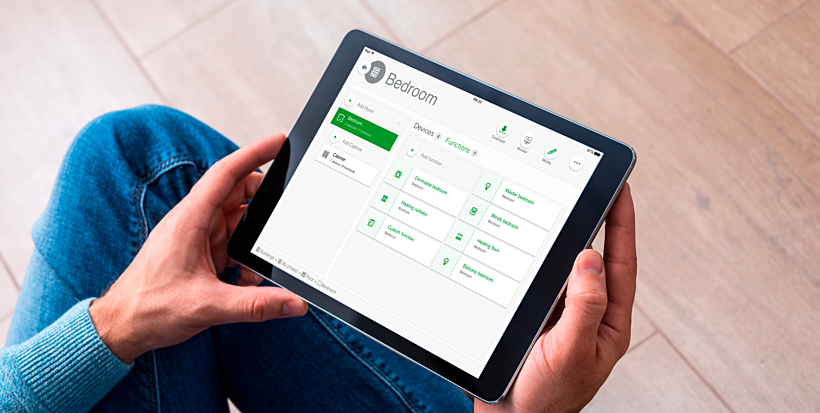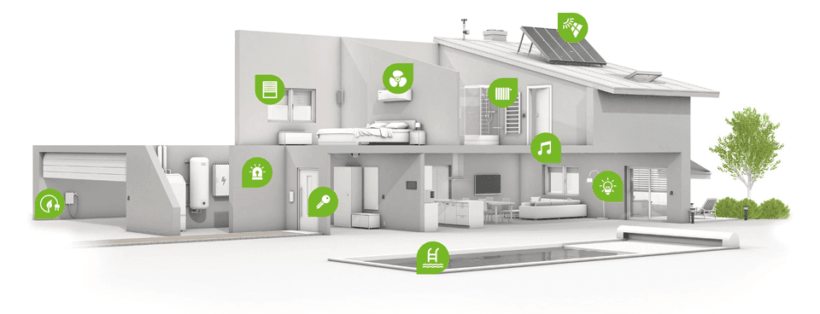
We're building a home: should we choose KNX or Loxone?
For newly built homes, a wired home automation system seems like the evident solution. In this article we compare two of the most widely spread wired solutions: KNX and Loxone.
Home automation for a newly built home
When it comes to home automation, it seems as if there's a never ending range of options to choose from. However, the options are usually narrowed down when making a comparison between a newly built home and a 'smart' upgrade of an existing home.
This article focuses on newly built homes. In the planning phase, everything is still possible and some sound choices at the start can go a long way. While wireless solutions are usually the only feasible/sensible option in an existing home, these can be considered less secure and reliable. Therefore, a wired solution is often the evident choice in a newly built home. There's a fair range of available options when it comes to wired solutions, but a few seem to pop up just slightly more often than others: KNX and Loxone—let's see how they compare.
The Facts
KNX
- International standard for building automation, which has been around since the nineties;
- Not linked to specific brands or manufacturers;
- It's decentralized, which means there's no central 'brain' of the installation;
- Proven and future proof technology;
- Can be extended with other technologies, like Loxone, but vice versa is less evident;
- The cabling (bus cable) can be used for other automation solutions as well;
- The system uses a star topology, meaning that every outlet, socket... is directly connected to the power board;
- They offer a limited control software (ETS Inside, only available for smartphone and tablet.), for more extended visualisation one must turn to 3rd party solutions;
- Requires an experienced installer/integrator and a license for KNX's ETS software to set up;
- Initial setup might be more expensive than Loxone for similar features.

With KNX's ETS Inside you can make small modifications to your set-up.
KNX
Loxone
- Relatively new but rapidly growing system;
- Closed system/no universal standard;
- Centralized: there's one central server to control every device;
- Can talk to KNX systems (to a certain extent);
- SVV-cable, which is harder to use for other types of solutions;
- The system uses a star topology as well;
- Includes user friendly software for the end user;
- Can be installed by tech savvy end user, even though the collaboration of a certified electrician is required for some aspects;
- Can be cost-effective if the built-in features are sufficient.

Loxone has one central server to control every device in your home.
Loxone
Face-off: comparing Loxone and KNX
Let's assume you are building a new home and need to make a choice between KNX and Loxone. The main aspects to keep in mind are cost, features and readiness for future expansion. Looking purely at initial investment, Loxone may be the more interesting choice. However, that also implies limitations in terms of other choices:
- Choosing for Loxone is a long-term choice. Since Loxone is a single manufacturer, that means that the choice is limited to products offered by Loxone. If Loxone ever stops its business or chooses updated standards, older hardware may become obsolete and/or difficult to maintain.
- De gustibus coloribusque non est disputandum, but choice in terms of style is limited to Loxone devices. So no light switches to match the wallpaper.
- If the central unit fails, all else fails as well: no lights, no music, no shades, no nothing.
While Loxone requires a smaller initial investment, KNX leaves more room for future expansion and offers more options in styles and products.
On the other hand, because everything needs to be planned and wired in advance, choosing for KNX is a long-term choice as well, even though it leaves more room for future expansion:
- Free choice in hardware and manufacturers leaves a lot of room for personal touches and styles. There's a vast range of styles, options and brands to choose from, going from budget options to luxury.
- There are multiple options available in terms of software: Savant Systems, Control4, and even open-source solutions like Home Assistant and OpenHAB can communicate with KNX to add extra layers of functionality.
- KNX is an open standard, which implies that it will probably outlive most of the hardware.
- As a decentralized system, all other devices will keep working when one or more devices fail.
Both solutions are easily expandable over time.
Conclusion
We can't make the choice for you, but if you intend to live in your new home for longer than a few years and you can do the initial investment, then KNX seems like the way forward. In other cases, you should seriously consider Loxone. We stated 5 dilemmas to help you decide which automation technology best suits your wants and needs.


